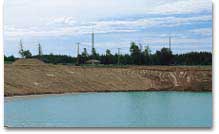Mines (Regulatory)
Land Access and Sustainable Development
Manitoba's Pit & Quarry Rehabilitation Program
Content Links:
 Implementing Sustainable Development
Implementing Sustainable Development
 What Is The Procedure After Applying?
What Is The Procedure After Applying?
 What Does It Cost The Land Owner?
What Does It Cost The Land Owner?
 What Constitutes 'Rehabilitation'?
What Constitutes 'Rehabilitation'?
Implementing Sustainable Development
The Manitoba Round Table on Sustainable Development identified site rehabilitation and remediation as one of the founding principles for building a better environment. This new program was developed as an aggregate industry initiative to implement sustainable development in relation to pits and quarries within the province. It provides an equitable and efficient means of funding rehabilitation work. At the same time, the contracting of the rehabilitation work back to private industry creates employment opportunities and spreads economic activity back into the local community.
Did you know that depleted pits and quarries can be rehabilitated at no cost to the land owner?
Building upon the initiative launched by the Manitoba Round Table on Sustainable Development, a new program was introduced in 1992 under the Mines and Minerals Act to rehabilitate depleted pits and quarries throughout the province.
A dedicated fund for this purpose has been established, based on a $0.12 per tonne environmental levy now collected on all current and future aggregate production. Since this program was introduced, hundreds of projects have been undertaken, rehabilitating thousands of acres of depleted pits and quarries across Manitoba.
Who May Apply To Have Rehabilitation Work Done?
Any land owner who has a depleted pit or quarry on their property may apply to have it rehabilitated.
This program was developed to address the rehabilitation of all sites, including those which will be depleted in the future as well as those mined out decades ago. The only qualification is that the site, or the portion of the site where work is proposed, must be depleted of economically valuable aggregate. Progressive rehabilitation is encouraged. This is where remedial measures are undertaken on depleted portions of a site while other parts are still being mined. In this way, the total area disturbed by mining can be minimized.
How Do I Apply?
Simply fill out and submit the Rehabilitation application form or telephone the request directly to the District Mines Inspector:
East Region |
Contact Resource Development Division |
204-945-1119 |
Southwest Region |
Tim Case |
204-726-7118 |
Northwest Region |
Tracy Grexton-Van Wynsberghe |
204-648-3808 |
What Is The Procedure After Applying?
Upon receiving your application, a department representative will meet with you on the site to detail the scope of the work which needs to be done. When agreement is reached on this description of work, you will be asked to sign a consent form authorizing access onto your property to carry out the site rehabilitation. The department representative then schedules the work and retains the services of a private contractor with equipment appropriate for the tasks (generally dozers and scrapers). The department oversees the contractor's work to ensure that it meets the standards of the program.



What Does It Cost The Land Owner?
There is no charge to the land owner for work carried out under this program. All costs incurred for hiring private equipment operators to do the work are paid from the environmental levy on aggregate production, which is set aside in the Rehabilitation Fund.


What Constitutes 'Rehabilitation'?
The public objective of the program is to ensure that depleted pits and quarries are rehabilitated to a condition which is "safe, environmentally stable, and compatible with adjoining lands." While each site is somewhat unique, achievement of this general standard involves sloping embankments and spreading the available overburden and topsoil stripping stockpiles back over the surface.
The public benefit is served once this standard has been reached. If the land owner then wishes to initiate further site development, to establish a housing subdivision or a golf course for example, they must do so at their own expense.


